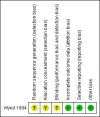Removal of nail polish and finger rings to prevent surgical infection
- PMID: 25089848
- PMCID: PMC7163182
- DOI: 10.1002/14651858.CD003325.pub3
Removal of nail polish and finger rings to prevent surgical infection
Abstract
Background: Surgical wound infections may be caused by the transfer of bacteria from the hands of surgical teams to patients during operations. Surgical scrubbing prior to surgery reduces the number of bacteria on the skin, but wearing rings and nail polish on the fingers may reduce the efficacy of scrubbing, as bacteria may remain in microscopic imperfections of nail polish and on the skin beneath rings.
Objectives: To assess the effect of the presence or absence of rings and nail polish on the hands of the surgical scrub team on postoperative wound infection rates.
Search methods: For this fifth update, we searched The Cochrane Wounds Group Specialised Register (searched 23 July 2014); The Cochrane Central Register of Controlled Trials (CENTRAL) (The Cochrane Library); Ovid MEDLINE; Ovid MEDLINE (In-Process & Other Non-Indexed Citations); Ovid EMBASE and EBSCO CINAHL.
Selection criteria: Randomised controlled trials (RCTs) evaluating the effect of wearing or removing finger rings and nail polish on the efficacy of the surgical scrub and postoperative wound infection rate.
Data collection and analysis: All abstracts were checked against a checklist to determine whether they fulfilled the inclusion criteria. Full reports of relevant studies were obtained. Excluded trial reports were checked by all review authors to ensure appropriate exclusion.
Main results: We identified: no new trials; no RCTs that compared wearing of rings with the removal of rings; and no trials of nail polish versus no nail polish that measured surgical infection rates. We found one small RCT (102 scrub nurses) that evaluated the effect of nail polish on the number of bacterial colony forming units left on hands after pre-operative surgical scrubbing. Nurses had either unpolished nails, freshly-applied nail polish (less than two days old), or old nail polish (more than four days old). There were no significant differences in the number of bacteria on hands between the groups before and after surgical scrubbing.
Authors' conclusions: No trials have investigated whether wearing nail polish or finger rings affects the rate of surgical wound infection. There is insufficient evidence to determine whether wearing nail polish affects the number of bacteria on the skin post-scrub.
Conflict of interest statement
None known.
Figures




Update of
-
Removal of nail polish and finger rings to prevent surgical infection.Cochrane Database Syst Rev. 2012 May 16;(5):CD003325. doi: 10.1002/14651858.CD003325.pub2. Cochrane Database Syst Rev. 2012. Update in: Cochrane Database Syst Rev. 2014 Aug 04;(8):CD003325. doi: 10.1002/14651858.CD003325.pub3. PMID: 22592690 Updated.
References
References to studies included in this review
Wynd 1994 {published data only}
-
- Wynd CA, Samstag D, Lapp AM. Bacterial carriage on the fingernails of OR nurses. AORN November 1994;60(5):796‐805. - PubMed
References to studies excluded from this review
Baumgardner 1993 {published data only}
-
- Baumgardner CA, Maragos CS, Walz MJ, Larson E. Effects of nail polish on microbial growth of fingernails. AORN 1993;58(1):84‐8. - PubMed
Edel 1998 {published data only}
-
- Edel E, Houston S, Kennedy V, LaRocco M. Impact of a 5‐minute scrub on the microbial flora found on artificial, polished, or natural fingernails of operating room personnel. Nursing Research 1998;47(1):54‐9. - PubMed
Hoffman 1985 {published data only}
Jacobson 1985 {published data only}
-
- Jacobson G, Thiele JE, McCune JH, Farrell LD. Handwashing: ring wearing and number of microorganisms. Nursing Research 1985;34(3):186‐8. - PubMed
Nicholson‐Pegg 1982 {published data only}
-
- Nicholson‐Pegg A. The wearing of wedding rings in the operating department. National Association of Theatre Nurses News 1982;19(4):19‐25. - PubMed
Salisbury 1997 {published data only}
-
- Salisbury DM, Hutfilz P, Treen LM, Bollin GE, Gautam S. The effect of rings on microbial load of health care workers' hands. American Journal of Infection Control 1997;25(1):24‐7. - PubMed
Additional references
AORN 1999
-
- AORN (Association of Operating Room Nurses). Recommended practices for surgical handscrub. AORN Journal 1999;69(4):842, 845, 846, 848‐50. - PubMed
Ayliffe 1999
-
- Ayliffe GAJ, Babb JR, Taylor LJ. Hospital acquired infection. Principles and prevention. 3rd Edition. London: Butterworth, 1999.
Gould 1997
-
- Gould D. Handwashing. Nursing Times 1997;93(37 Suppl):1‐2. - PubMed
Higgins 2003
Higgins 2011
-
- Higgins JPT and Altman DG on behalf of the Cochrane Statistical Methods Group and the Cochrane Bias Methods Group (Editors). Chapter 8: Assessing risk of bias in included studies. In: Higgins JPT, Green S (editors). Cochrane Handbook for Systematic Reviews of Interventions Version 5.1.0 [updated March 2011]. The Cochrane Collaboration, 2011. Available from www.cochrane‐handbook.org.
Kerr 1998
-
- Kerr J. Handwashing. Nursing Standard 1998;12(51):35‐42. - PubMed
Lefebvre 2011
-
- Lefebvre C, Manheimer E, Glanville J, on behalf of the Cochrane Information Retrieval Methods Group. Chapter 6: Searching for studies. n: Higgins JPT, Green S (editors). Cochrane Handbook for Systematic Reviews of Interventions Version 5.1.0 [updated March 2011]. The Cochrane Collaboration, 2011. Available from www.cochrane‐handbook.org.
May 1998
-
- May H. Now wash your hands. Nursing Times 1998;94(4):63‐6. - PubMed
NINSS 1999 [Computer program]
-
- NINSS (Nosocomial Infection National Surveillance Scheme). Analysis of a years surveillance in English Hospitals 1997‐1998. Public Health Laboratory Service www.phls.co, 1999.
Plowman 1999
-
- Plowman R, Graves N, Griffin M, Roberts JA, Swan AV, Cookson B, et al. The socio‐economic burden of hospital acquired infection. Public Health Laboratory Service 1999.
Price 1938
-
- Price PB. The classification of transient and resident microbes. Journal of Infectious Disease 1938;63:301‐8.
SIGN 2011
-
- Scottish Intercollegiate Guidelines Network (SIGN). Search filters. http://www.sign.ac.uk/methodology/filters.html#random 2011.
Wilson 1995
-
- Wilson J. Infection control in clinical practice. London: Balliere Tindall, 1995.
Publication types
MeSH terms
Substances
LinkOut - more resources
Full Text Sources
Other Literature Sources
Medical

